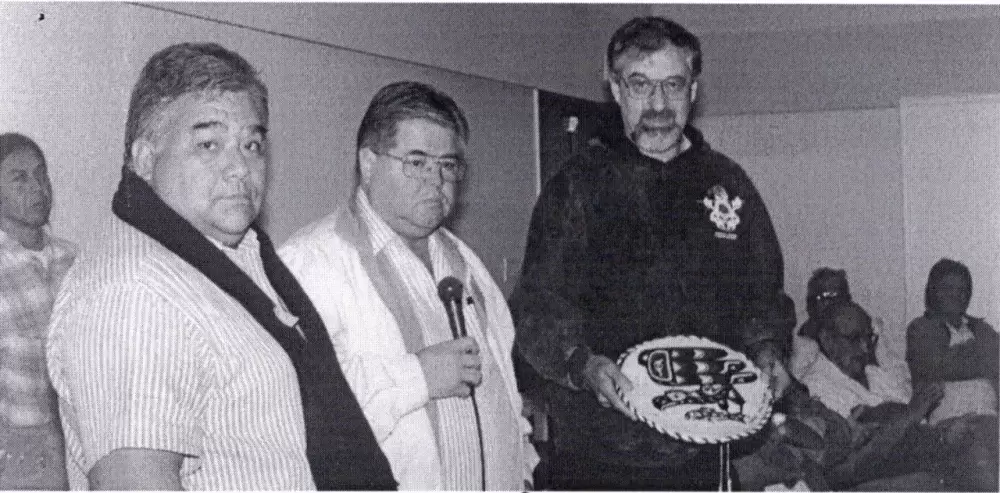The man known throughout Nuu-chah-nulth territory as Hashilthsa Bob - who worked at Canada’s oldest First Nations newspaper for most of its history - died early today at the age of 73.
Bob Soderlund, or Haiupinulth in his adopted Tseshaht family, passed on Sept. 21 in the Philippines city of Angelise with his wife Nerlita by his side. He had just made one of his regular trips to the Philippines’ Leyte Islands to be with Nerlita on her birthday.
The loss has rippled through Nuu-chah-nulth communities, where Soderlund solidified a reputation for documenting events. His time at the Ha-Shilth-Sa began with its first issue on Jan. 24, 1974, when Soderlund contributed as a volunteer in the darkroom developing photographs. At that time photography was a hobby, but the skill would lead to Soderlund becoming editor of the paper a few years later, a role he would keep until 1998.
Ha-Shilth-Sa reporter Denise Titian started at the newspaper in 1996 when Soderlund was still at the helm, but her connection to the man started long before.
“I met Bob in the summer of 1980 when he came to my wedding,” she recalled. “He later gave me a set of photos he took from the wedding.”
“Bob was always behind his camera,” commented Judith Sayers, president of the Nuu-chah-nulth Tribal Council who previously served as elected chief of the Hupacasath First Nation. “It is a big loss, not only the Watts family, but to the entire Nuu-chah-nulth people. He was such a part of us.”
“He was well known for his photography skills and when I came to work for him in 1996 the first order of business was a lesson on how to use the Pentax K1000. That was his favorite camera,” said Titian. “Back in those days he still had the huge drafting table where he would lay out the Ha-Shilth-Sa, literally by hand. He would stay at the office until 2 a.m., painstakingly cutting text and pasting them onto a board, to make the Ha-Shilth-Sa newspaper.”
“He still had a darkroom in the corner of the office so that he could develop his own images,” she added. “He was old-school, like that. He had a kind, laid-back management style and a dry sense of humor.”
Lillian Webster remembers Soderlund’s brand of humour from his trips to Ahousaht. Her late husband Wes Thomas became close friends with Soderlund after the two met outside Ahousaht’s T-bird Hall during a New Year’s Eve dance. When Thomas learned that the photographer had nowhere to stay he brought him home. From that day forward, Soderlund always stayed at Wes and Lil’s in Ahousaht, asking if the couch was available. Even after Wes passed away, Bob always came to Lil’s house, bringing her a shirt he printed. She would give him jarred fish or fresh bread in exchange.
When asked about how close Wes and Bob were, she said, “They must be celebrating together in heaven.”
Hugh Braker recently bought some of Soderlund’s shirts that were made for the upcoming Orange Shirt Day on Sept. 28, a national recognition for former residential school students. Soderlund went to high school with the late George Watts, who helped found the West Coast District Council of Indian Chiefs, now known as the Nuu-chah-nulth Tribal Council. Over the years the photographer became an integral part of the Watts family, leading to his adoption by the late Hughie and Grace Watts.
“All of my mother’s siblings called him brother,” said Braker. “He never had children himself, and so in our family he became like a favourite uncle because he would buy presents for everybody, even though our family is so big.”
Soderlund was subsequently adopted into Tseshaht by Ha’wilth Adam Shewish, who named him Haiupinulth after a chief from long ago.
“It’s a very high-ranking name,” said Braker, who received dozens of condolences on the morning of Soderlund’s passing from the many First Nations people who affectionately referred to Soderlund as “Suds”.
“It was very rare to go to a potlatch without seeing Suds there - not only would he go, but he would participate,” added Braker. “When my family stood up he would stand up with us. He spoke a lot of our language, a lot of people don’t realize it.”
Now Soderlund’s adoptive family is tasked with figuring out what to do with the man’s extensive collective of photographs.
“He had a wealth of photographs of all of the Nuu-chah-nulth villages, and many of them of elders who are now deceased,” said Braker.
“I am grateful for the time I got to work for him, learn from him and for his continued friendship over the decades. He will be missed,” added Titian.
A celebration of Bob Soderlund’s legacy is being planned to take place in Tseshaht territory.
With notes from Denise Titian







